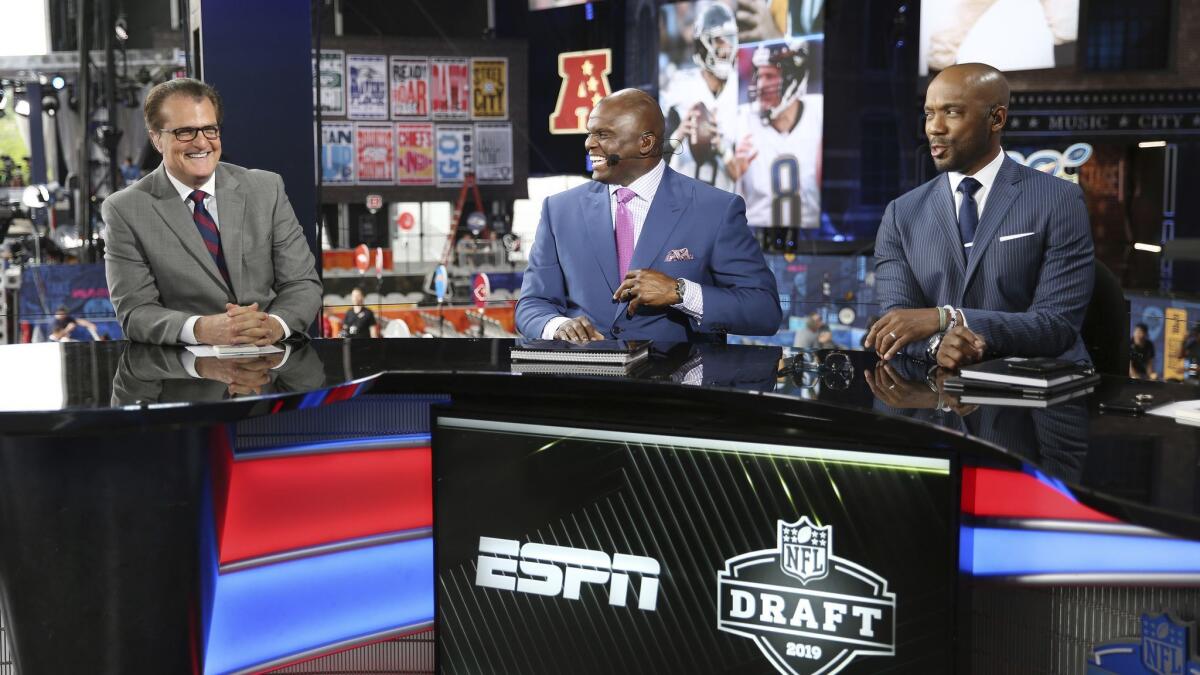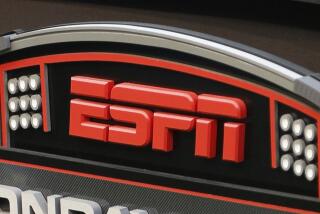ESPN President Jimmy Pitaro is fighting the cord-cutting wave
- Share via
When the 2019 NFL draft took over downtown Nashville last month, ESPN became a city within the city, with more than 600 staffers and freelancers on site, and its top executive, Jimmy Pitaro, surveyed the scene like its mayor.
Pitaro shook hands and introduced himself to every ESPN employee in his path as he toured the red brick brewery on Honky Tonk Highway where the sports media behemoth was based for 90 hours of live draft coverage. (“I’m Jimmy,” was his opening line.) But the New York Giants fan in him took over when he ran into “NFL Primetime” host Trey Wingo.
“Tell me real quickly — what are the Giants going to do?”
Wingo told Pitaro that his fellow ESPN analyst Mel Kiper Jr. was certain the Giants were targeting Duke quarterback Daniel Jones, a prediction that proved correct several hours later.
Such insider information is why Pitaro, 49, loved ESPN as a sports-obsessed schoolboy athlete in Edgemont, a Westchester County, N.Y., hamlet 15 miles north of Yankee Stadium. “I grew up as a huge ESPN fan, not just a sports fan,” he told The Times.
His passion for the network is what drove the veteran Walt Disney Co. executive to aggressively pursue the president’s job at ESPN after John Skipper resigned suddenly in December 2017 to deal with a substance abuse issue.
Pitaro took over ESPN in March 2018 after spending eight years running Disney’s interactive and consumer products divisions. He confronted a tricky task: maintaining ESPN’s highly profitable but maturing core television business at a time when the company was roiled by subscriber losses, layoffs and a perception by some on Wall Street that it was a problem for Disney.
Although challenges remain, analysts and colleagues credit Pitaro for bringing stability to the iconic company and finding new ways to reach out to younger audiences.
Pitaro, whose ties to the sports business began as he rose through the media division at tech company Yahoo, was eager to take on ESPN even as the media described a company in disarray, according to friends.
“We were having coffee on the Disney lot, and I said something like, ‘Dude, you guys are getting beat up,’” said Todd duBoef, president of Top Rank Boxing. “He said, ‘Every day, I see the headlines and I think: “What, am I crazy? I just want to go for it.”’ He was not afraid of the challenge.”
So far, Disney Chief Executive Bob Iger is happy with Pitaro’s progress. Appearing at a recent investors conference, Iger credited Pitaro with dialing down the political discourse on ESPN’s debate shows and its signature program “SportsCenter,” as well as lifting ratings. He also believes Pitaro has improved relationships with sport leagues doing business with the network, especially the NFL. (ESPN’s $1.9-billion-a-year deal to carry “NFL Monday Night Football” runs through the 2021 season.)
“We’ve done some brand research that suggests ESPN’s brand is stronger than it was a few years ago,” Iger said. “In general, if you look at what Jimmy’s performance has been ... it’s been really positive.”
Although Pitaro has calmed the turbulence that plagued ESPN in the years before he arrived, much of his focus is on preparing the Bristol, Conn., network for rapid changes in the TV industry. A month after he arrived, ESPN launched its subscription streaming service ESPN+, which offers users live sports events and original programming not available on its TV channels for $4.99 a month. After a year on the market, ESPN+ is ahead of projections with more than 2 million subscribers.

Touting ESPN+ is a bit of a balancing act. Pitaro emphasized that it’s meant to be a complementary service not intended to replace the habit of watching ESPN on cable or satellite (a former litigator, Pitaro is always precise in his language). But he acknowledged that ESPN+ does offer the ability to reach consumers if the pay-TV habit keeps dissipating.
“If the world moves in [that] direction, we want to be well set up for it, and we are,” Pitaro said. “We have a product that works.”
One of Pitaro’s priorities is to get ESPN’s brand and programming in front of the growing numbers of consumers who are not watching cable TV. According to research firm EMarketer, the number of people without pay-TV subscriptions will grow 19% to 39.3 million in 2019.
On that front, ESPN has also expanded its program offerings on YouTube and social media apps such as Twitter — where 5.5 million viewers watched “On the Clock,” live NFL draft coverage produced exclusively for that audience. There is also a brisk version of “SportsCenter” designed for Snapchat users to watch on mobile devices.
Pitaro said “the angels started singing” after an employee told him about three 13-year-olds who started watching “SportsCenter” on TV after discovering it on Snapchat. “That’s exactly what we’re going after,” he said.
ESPN has expanded its reach by putting more of its produced NBA games, NFL draft coverage and college football contests on the Disney-owned ABC broadcast network, which is available for free to anyone with a TV antenna.
ESPN is also using ESPN+ to broaden its range of live events. The network teamed with Disney’s recently created direct-to-consumer division for a $1.5-billion deal with Ultimate Fighting Championship to carry mixed martial arts events.
The first show in January, which included a championship fight available exclusively on ESPN+, brought 600,000 new subscribers to the streaming service. (Pitaro also has anecdotal evidence that combat sports can draw younger fans — his 15-year-old son, Sean, his oldest of two children, has taken up boxing and spars in the ring four days a week.)
Pitaro has also satisfied ESPN’s more traditional fans by steering commentators away from political discussions on-air and on social media, which heightened during President Trump’s criticism of NFL player protests against social injustice during the playing of the national anthem.
“Without question our data tells us our fans do not want us to cover politics,” Pitaro said. “My job is to provide clarity. I really believe that some of our talent was confused on what was expected of them. If you fast-forward to today, I don’t believe they are confused.”
Another change, insiders say, is that ESPN has been more closely integrated into the parent company. ESPN, which is 100 miles outside New York City, had long operated autonomously and did not always embrace the Disney culture. Many sports industry executives believe Iger used Skipper’s exit as an opportunity to change that.
“Having somebody who cares as deeply about ESPN fans as Jimmy does — because he’s grown up on ESPN as a consumer — but also understands and believes in the merits of the Disney way, is a really nice match,” said Mike Levine, co-head of sports at talent agency CAA and a longtime friend of Pitaro.
Pitaro, who played football at Cornell University before getting his law degree, joined Disney in 2010. But he also knows Hollywood through his 22-year marriage to actress Jean Louisa Kelly, who travels back to the West Coast for work (she has roles in the upcoming features “Top Gun: Maverick” and “Call of the Wild”).
His passion for sports keeps Pitaro from being seen as a Disney executive trying to keep the Bristol campus in line. “SportsCenter” anchor Scott Van Pelt said it was shortly after his first meeting with his new boss that they bet a cafeteria dinner on the results of a University of Maryland-Cornell lacrosse matchup.
Under Pitaro, ESPN has capitalized on the move toward legalized sports betting. The network recently launched “Daily Wager,” a program looking at sports through a bettor’s lens. On May 14, ESPN announced it will build a studio at a Caesars Entertainment hotel in Las Vegas as a site for more gambling-related shows.

Patrick Rishe, director of the sports business program at Washington University in St. Louis, said the expansive moves are a sign that ESPN is recognizing the shift in consumer taste and viewing habits.
“Pitaro has done a skillful job assessing the changing landscape,” Rishe said. “ESPN has shown an adaptability and humility they haven’t always possessed.”
The test for Pitaro will be whether ESPN’s revenue growth from streaming and programming expansion can make up for the TV subscriber losses over the long term.
In recent years, ESPN has laid off hundreds of workers in the face of declining subscriptions. Subscriber levels have declined from a peak of 100 million in 2010 to about 85 million, according to Nielsen data.
But ESPN still remains a major profit center for Disney. Disney does not break out ESPN’s financials, but research firm S&P Global Market Intelligence says its revenue for 2018 totaled $10.2 billion, up 6% from the previous year, and it had cash flow of $3.23 billion, up nearly 8%. Even with cord-cutting, ESPN’s revenue from pay-TV subscriptions increased 6% to $7.3 billion.
During its recent first-quarter earnings call, Disney said ESPN’s rate increases from pay-TV providers were higher than a year ago and adjusted TV advertising revenue was up in the mid-single-digit range thanks to strong demand for commercial time — a positive sign as the network enters the advanced sales market for the 2019-20 TV season that began last week.
Pitaro said there are no plans for more layoffs at the 7,000-employee company.
“We like the state of our business right now,” Pitaro said. “I feel like we’re operating at an efficient level.”
ESPN still has the valuable weapon of live programming, which has protected it from the kind of ratings declines that networks are experiencing, as scripted dramas and comedies can be streamed anytime. ESPN has seen year-to-year audience increases in its NFL, Major League Baseball and college basketball telecasts. The network recently had its most watched NBA Conference Finals game since 2012 and viewing for the lottery determining the order of the league’s upcoming draft was up 77% from last year.
Controlling the cost of those live events will not be easy, as tech giants such as Amazon, Apple and Google are expected to become more aggressive in pursuing sports properties, including the NFL. Pitaro believes ESPN’s track record will help fend off the emerging competitors.
“We have the best production team in the business,” he said. “The leagues really appreciate the scale that we offer across our various platforms.”
There have been rumors that Disney wants to bring the NFL to ABC, putting the network in rotation for the ad-revenue-rich Super Bowl that is currently not part of ESPN’s package of Monday night games.
Pitaro said there have been no discussions with the NFL about its next contract. But he said he is open to having ABC included in a new deal. “If we believe bringing ABC to the table is what’s best for Disney, that is absolutely what we’re going to do,” he said.
Another high priority is to bolster relationships ESPN has with sports leagues (he huddled with NFL Commissioner Roger Goodell during the Nashville trip). But Pitaro is careful to point out that the journalism side of ESPN will continue to cover those leagues aggressively.
“When they hear me talking about the importance of league relationships, it is not code for we can ‘no longer do what we do on the investigative reporting side,’” he said. “It’s my job to figure out how to navigate those waters and make both aspects of the business work. We have started to look at processes about keeping me informed. The last thing I’m going to do is interfere with the journalistic process.”
More to Read
Inside the business of entertainment
The Wide Shot brings you news, analysis and insights on everything from streaming wars to production — and what it all means for the future.
You may occasionally receive promotional content from the Los Angeles Times.










